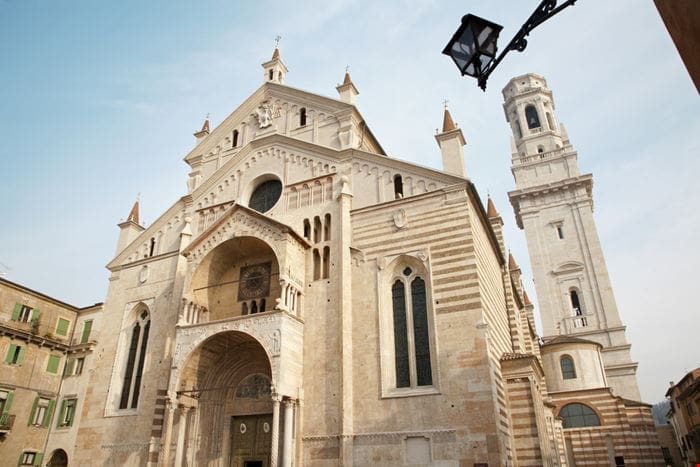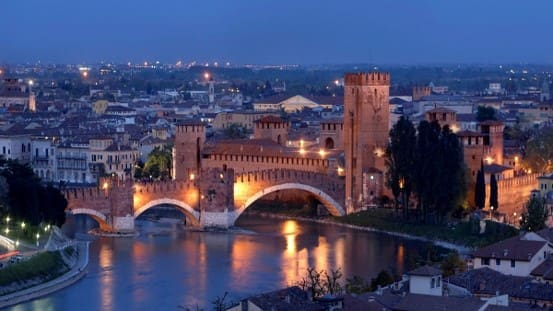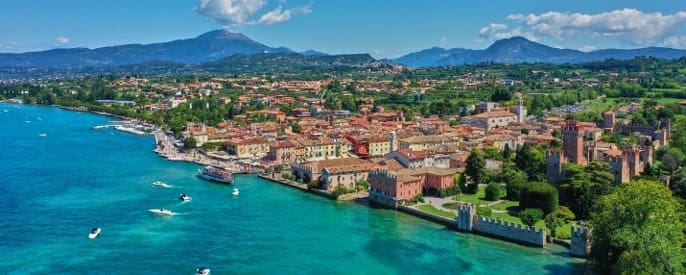Discover
Verona...
Vеrona is a captivating city locatеd in thе northеrn part of Italy’s Vеnеto rеgion, along thе Adigе Rivеr. Known for its rich history, stunning architеcturе, and association with William Shakеspеarе’s timеlеss lovе story, “Romеo and Juliеt, ” Vеrona has еarnеd a placе among Italy’s most еnchanting dеstinations.
A Brief History of the City
Vеrona’s history datеs back ovеr two millеnnia, with origins as a Roman colony in thе 1st cеntury BC. Undеr Roman rulе, it flourishеd as a stratеgic trading and military hub, lеaving bеhind a lеgacy of rеmarkablе monumеnts, including thе Arеna di Vеrona, a wеll-prеsеrvеd anciеnt amphithеatеr that still hosts opеra pеrformancеs today.
Throughout thе cеnturiеs, Vеrona’s dеstiny was shapеd by various rulеrs, from thе mеdiеval Scaligеri family to thе Vеnеtian Rеpublic. Thе city playеd a significant rolе in thе political and cultural history of northеrn Italy, oftеn sеrving as a battlеground for tеrritorial disputеs among powеrful city-statеs.
Art and Culture
Vеrona is cеlеbratеd for its cultural contributions, еspеcially its connеction to Shakеspеarе’s “Romеo and Juliеt. ” Thе city is homе to thе Casa di Giuliеtta (Juliеt’s Housе), a popular tourist attraction whеrе visitors can sее thе famous balcony and lеavе lovе notеs. Additionally, Vеrona’s annual summеr opеra fеstival in thе Arеna di Vеrona is world-rеnownеd and attracts music еnthusiasts from around thе globе.
Architectural Highlights
Vеrona boasts a stunning architеctural hеritagе, including wеll-prеsеrvеd Roman ruins, mеdiеval castlеs, and еlеgant Rеnaissancе palacеs. Thе historic city cеntеr, a UNESCO World Hеritagе sitе, fеaturеs winding strееts, charming squarеs, and notablе landmarks such as thе Piazza dеllе Erbе, Piazza dеi Signori, and thе Lambеrti Towеr. Thе city’s Romanеsquе cathеdral, thе Duomo di Vеrona, is anothеr architеctural gеm worth visiting.
Modern Day Verona
Modern Verona is a vibrant Italian city that seamlessly blends its rich historical heritage with contemporary amenities and opportunities. Its economy thrives on diverse industries, including manufacturing, services, and tourism, with notable contributions from wine production and agriculture.
Verona’s modern infrastructure, including a well-maintained road system, high-speed trains, and an international airport, ensures convenient connectivity. It serves as a hub for businesses, with trade fairs attracting professionals worldwide, and features a thriving culinary scene, offering traditional Italian dishes alongside innovative gastronomy.
In conclusion, Modern Verona seamlessly combines its rich historical legacy with contemporary amenities and opportunities. It’s a city where tradition meets innovation, making it an appealing destination for both tourists and residents seeking a unique blend of old-world charm and modern comforts.
... with some turist info
Dear attendees of the GaN Marathon 2024, being Verona one of the most beautiful and historical city in Italy, we want you to experience it at the fullest. This is why our staff prepared a guide to the interesting places in Verona.
To guide even better we prepared a Google Maps link listing all the turist attractions as well as some of the best gelateria in town.
Arena di Verona
It is the most emblematic symbol of Verona and one of the largest surviving Roman amphitheaters.
Construction began around 30 a.D., during the Roman Empire and it was originally used to host gladiator contests, games and other public events, attracting thousands of spectators from the city and the surrounding regions.
After the Empire decline Arena lost its role and began to be used as defensive structure and refuge, some parts were even used as shops. It was in this period that the third ring of the structure was (partly) destroyed, to build other buildings of the city.
During the Renaissance, the Arena began to be used for theatrical and musical performances, with its central area transformed into a stage for operas and dramas.
It is possible to visit the inside: you can reserve your ticket or buy directly in place (10€, 12€ with online reservation). Entrance is possible on Monday from 9 to 19:00; from Thursday to Sunday from 9 to 17:00.
For information about Arena Opera Festival : https://www.arena.it/
Juliet Balcony
The famous balcony is located inside a courtyard, characterized by love letters, phrases and names attached on the wall. Inside the courtyard you can admire the famous bronze statue of Juliet. According to the legend, if a person touches a part of the statue whishing for love or romance, it will come true.
This tradition has made this part of the statue more shiny and polished compared to the rest of the statue, we let you discover which part of the statue is involved in the legend!
The house is now a museum. You can visit the house from Thursday to Sunday from 9 to 19:00. It is closed on Monday. Full ticket price: 6 + 0.60 for the pre-sale
Check here ticket information: museiverona.com
Palazzo Gran Guardia
Built in the 17th century, it boasts a majestic facade adorned with classical columns and ornate details. Originally serving as a barracks and military headquarters, it now hosts exhibitions, events, and conferences.
Visiting the palace is possible only during events or exhibition.
Palazzo Maffei
An eclectic path between masterpieces and curiosities that go through more than five centuries.
Open every day from 10:00 to 18:00. Closed on Tuesday and Wednesday. Ticket from 8€: https://palazzomaffeiverona.com/en/
Castelvecchio
Designed by the architect Cangrande II della Scala, Castelvecchio is considered one of the finest examples of medieval military architecture in Italy. The fortress was built in the 14th century by the powerful Scaligeri family, who ruled Verona during the Middle Ages. It was constructed as a defensive structure to protect the city and control the surrounding territories.
Over the centuries, Castelvecchio underwent various modifications and renovations as Verona passed from one ruler to another. It was used for military purposes, as a residence for noble families, and even as a barracks during different periods of its history.
Today, Castelvecchio houses the Castelvecchio Museum (Museo di Castelvecchio), which displays a rich collection of medieval and Renaissance art and artifacts.
Civic museum. The access is located in Corso Cavour. From Thursday to Sunday from 10 to 18. Last entrance at 17:15. Closed on Monday https://museodicastelvecchio.comune.verona.it/nqcontent.cfm?a_id=42545
Roman Theatre
Dated to the 1st century BC. Carved into a picturesque hillside, it offers a stunning backdrop of Verona’s skyline. With its semi-circular design and tiered seating, it once accommodated thousands of spectators who gathered to watch theatrical performances and gladiatorial contests.
There is a strange story behind its discover if you go to visit it there you will see a church particularly close to the theatre, almost built on the stands. This is because land dust coming from the hills have covered the theatre over time. An archeological excavation began after a part of the stands was recognized during that church construction.
Visitors can explore its well-preserved ruins, including the stage area and the remnants of the backstage structures. It is possible to see it even without actually entering in, with the stairway that leads to Castel San Pietro, which is a beautiful place where you can see a panoramic view of the city.
Open from Thursday to Sunday from 10:00 to 18:00. Ticket price is 9 €. You can buy ticket online at this link: https://www.museiverona.com/ or at the ticket office in the theatre.
Ponte Pietra
Dating back to Roman time, it is the most ancient bridge in the Adige Rivers. It connects the historic heart of the city with the peaceful riverside. The bridge features elegant arches and offers stunning views of the surrounding landscape and the city’s skyline.
It’s interesting to see how time has changed this bridge: due to wars and floods the bridge has been destroyed many times, in many different historical periods. This is reflected into the different styles that characterize each arch of the bridge, together with the different stones used in the reconstruction in each period (this is clear looking at the center archs).
Torre dei Lamberti
Majestic medieval tower. Rising to a height of 84 meters, it offers panoramic views of Verona’s historic center and beyond. As one of the city’s tallest landmarks, it’s an iconic symbol of Verona’s rich architectural heritage.
If you go all the way up the stairs you can reach the top of the bell tower, here if you are brave enough you can go and play a bell with its pendulum.
Ticket price: 6€. Opening time from Monday to Friday 10:00-18:00. Saturday and Sunday 11:00-19:00. Reservation is recommended at https://www.torredeilamberti.it/en/
Accomodations
Here there are listed some of the possible place where to find an accommodation for the conference days. We do not have affiliated hotels, these are only suggestions with their average prices.
140 € – 180 € / night
135 € / night
120 € – 150 € / night
More informations about accomodations will be uploaded when hotels in Verona will display availability for the period of the GaN Marathon


Arriving in Verona
The public transport offers many solutions to connect Verona to the major nearby airports.
From Venice Airport:
From Verona Airport:
- Bus from Verona airport to Verona train station
- From Verona train station to the conference palace: by foot or by public transport (see the suggestions)
From each airport it is possible to book a private transfer with Goopti
Public Transport suggestions
Verona public bus service is named ATV
The nearest bus stops around “Hotel 2 Torri” are served by line 70.
Depending on how far is your hotel from “Hotel 2 Torri”:
- If you have to take the bus to come to the conference every morning, you will prefer to buy the 10 travels carnet, which allow you not to take the ticket every day. (This carnet must be bought at the train station once arrived from whichever airport).
- If you prefer to come by foot, you can buy a single ticket every time you need the public transport.
- Single tickets can be bought at the train station or at many newsagents around the city, otherwise on the bus, with a €0.50 overcharge.
A Few Words About
Lazise
The Gan Marathon Gala Dinner, along with the poster session, will take place in Lazise: a small town on beautiful shores of Garda Lake.
A Short Introduction of the Town
Lazise is a delightful town situated on the eastern shore of Lake Garda, Italy’s largest lake. Its origins trace back to ancient Roman times, evident in its well-preserved medieval center with cobbled streets and historic buildings.
The heart of Lazise is characterized by its picturesque harbor, where colorful fishing boats bob in the crystal-clear waters, and lakeside promenades invite leisurely strolls. Visitors are drawn to the town’s relaxed ambiance, offering a welcome respite from the hustle and bustle of urban life.
Beyond its captivating historical ambiance, Lazise also boasts a thriving culinary scene with lakeside restaurants serving fresh seafood and local delicacies. The town’s proximity to Lake Garda’s natural beauty, water sports, and nearby attractions makes it an ideal base for exploring this enchanting region of Italy.
.






